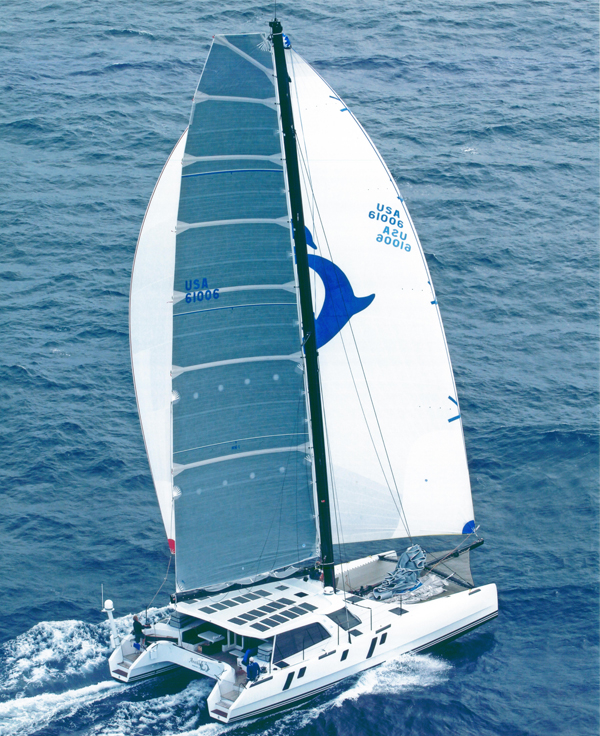Youth Teams Enter Newport Bermuda Race
For some people, thrash, whether used as a noun or a verb, sounds like a bad thing. But for the 1500+ sailors on 180 vessels entered in the 51st “Thrash to the Onion Patch,” more formally known as the Newport Bermuda Race, this biennial race is a bucket list challenge.
When the boats – in seven divisions – depart Narragansett Bay starting at 1:00 p.m. on Friday, June 15, 2018, they face 635 miles of ocean and two to six days of sailing [depending on the boat’s size], making “thrash” an apropos nickname for this race.
The youth crew of the 63-foot Young American – Gambler during a practice session in late May [Photo courtesy of Will McKeige]
Writing a new storyline in Newport Bermuda Race history are three youth teams [ages 14-23] who will be competing. The genesis for this youth movement began with Peter Becker [Rye, N.Y.] who put together a team of seven junior sailors and three adult coaches to sail the 2016 race.
In a 133-strong fleet, they were the second boat to arrive in Bermuda, bested only by the record-breaking maxi yacht Comanche. Becker has since started the Young American Sailing Academy [YASA] to maximize opportunities for youth sailors to get offshore sailing experience.
The youth teams entered for 2018 are Dreamcatcher, the offshore team of the Stonington, Connecticut-based youth sailing organization, MudRatz, which also aims to help young sailors learn advanced techniques and strategies; and Feo, which will have New Yorker Isabel “Izze” Best, the 18-year-old daughter of owner Eric Best, and five of her friends making all the decisions while her father takes the non-speaking role of crew chef to meet his insurance company’s requirement that he be aboard for the passage. YASA will also be back with several veterans from 2016 in a crew of 16 primarily college-aged sailors onYoung American – Gambler, a Reichel-Pugh 63.
The youth crew of the 48-foot Dreamcatcher gets set for a practice race around Block Island in late May
“In terms of starting an ocean sailing career, young is better,” said veteran racer John Winder [Essex, Mass.], who did his first Newport Bermuda Race at the age of 18 in 1970, having been ocean sailing with his family from the age of 14. “I started early, and familiarity with the motion of the boat and the wind in your face allows you to develop a sixth sense until handling everything aboard becomes second nature.”
“These kids have all grown up in Optis and 420s,” Winder added. “This is their first experience with a big, offshore boat. They are acclimated to being on the water, but not to the weight of a big boat and how much longer maneuvers take to do.
“They are absolute sponges for information, aiding them in becoming experienced as offshore sailors on top of their dinghy expertise. We’re immersing them in basic seamanship drills with consistent, repetitive, safety training. The result is a well-rounded offshore sailor.”
The Gunboat 60 Arethusa owned by Phil and Wendy Lotz will sail in the new Multihull division
Rhode Island Sailors Join the Thrash
Rhode Island’s Bristol Yacht Club [started in 1877 by a group of college sailors from Brown University] will be well represented with four boats in the race: Joe Brito with J/121 hull No.1 Incognito; John Bell on the Aerodyne 47 Moon Shadow; Ray Renaud on the C&C 35 Mk II Aggressive; and the Sydney 36Shearwater owned by Chris Bjerregaard and Joe Whelan.
Bjerregaard’s first Newport Bermuda Race was in 2012, as a crew on an X41. He will race this time with wife June, their daughter Kate [20] and son Ted [18], the latter a recent graduate of St. George’s School where he was a member of the sailing team. At press time, Kate, St. Mary’s College of Maryland ’19, was competing at the ICSA College National Championships.
The siblings will handle the bow, and Whelan will be the other watch captain. Also joining them are friends Ken Madsen and the only non-Bristol resident onboard, Karl Wenner of Klamath Falls, Ore., who went to college with Bjerregaard.
“This will be the second time attempting the race on our boat,” said Bjerregaard. He and Whelan turned back early in the 2016 race when the newly replaced starter on Shearwater failed. “I didn’t think it was a good thing going into heavy weather without power.
So, you could say we have some unfinished business.” For the four days leading into the race, they’ll get the crew on the water practicing, among other things, man overboard drills.





